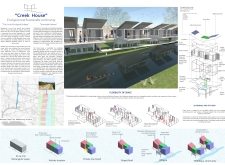5 key facts about this project
At its core, the Creek House is designed to function as a residential community that integrates seamlessly with its natural surroundings, specifically the Mooney Creek Trail. It represents a vision of modern living where individuals can thrive in a communal setting while preserving and respecting the ecological landscape. This emphasis on community engagement is vital in urban settings, where social isolation can often pose significant challenges.
The project incorporates multiple important elements that contribute to its overall function and efficacy. The architectural layout is meticulously crafted, offering a blend of private and shared spaces. Sliding folding shutters are a notable design feature that enhances adaptability, enabling residents to modify their living areas according to their needs. This flexibility is not only practical but also encourages interaction among community members, fostering a cooperative living environment.
Material selection plays a crucial role in the Creek House design. The use of corrugated sheets made from recycled Tetra Pak beverage cartons exemplifies a commitment to sustainability and resourcefulness. Double-glazed glass is employed to maximize natural light and energy efficiency, creating light-filled interiors that reduce reliance on artificial lighting. The integration of a green roof not only enhances visual aesthetics but also offers ecological benefits, promoting biodiversity and reducing heat retention. In addition, solar panels are strategically placed to harness renewable energy, supporting the project’s intention for energy autonomy.
A unique aspect of the design is the incorporation of a bio-toilet system connected to a bio-gas digester. This innovative approach to waste management aligns with principles of a circular economy, encouraging sustainable practices within the community. Furthermore, a rainwater harvesting system enhances water efficiency, making the Creek House not just an individual living space but a model of responsible living in an urban context.
The project is not simply about creating functional housing; it is about building a community that thrives on shared values and interactions. The common recreational areas and shared platforms are thoughtfully designed to foster social connections and engagement among residents. This community-centered focus aligns with contemporary urban living trends that emphasize the importance of connectivity and collaboration.
As this project encapsulates a multifaceted approach to modern architecture, it serves as an exemplar of how thoughtful design can meet the needs of both people and the environment. The Creek House redefines traditional notions of residential spaces, advocating for a model that embraces sustainability, flexibility, and community.
For those interested in a comprehensive understanding of this project, exploring the architectural plans, sections, designs, and underlying ideas will offer deeper insights into the innovative approaches employed within the Creek House initiative. Engaging with these elements will reveal how design can effectively address urban challenges while promoting a cohesive and sustainable community living experience.























